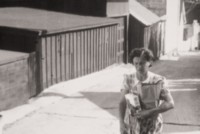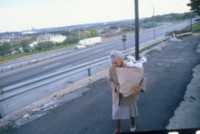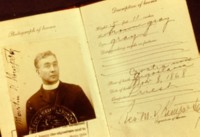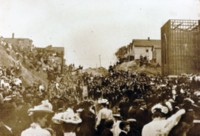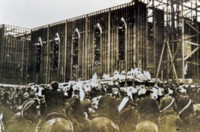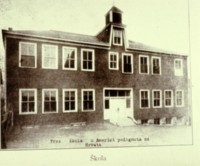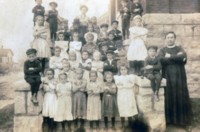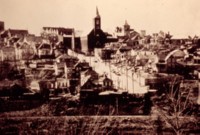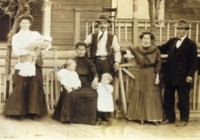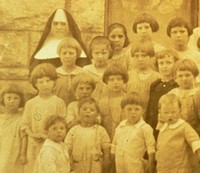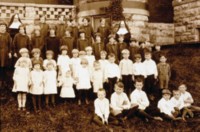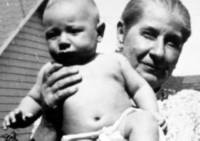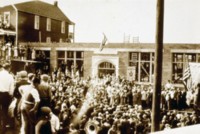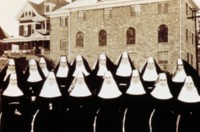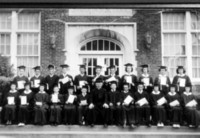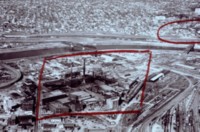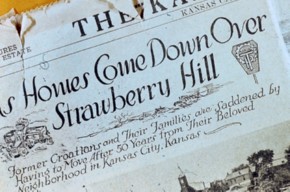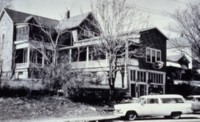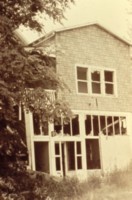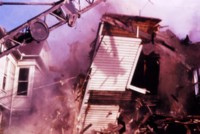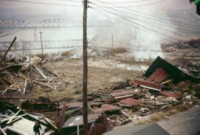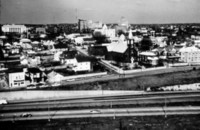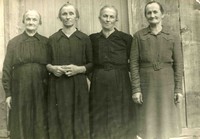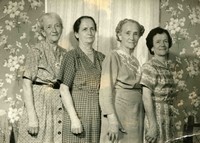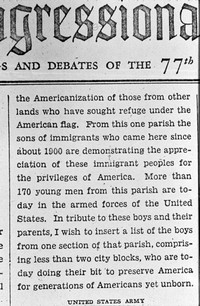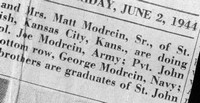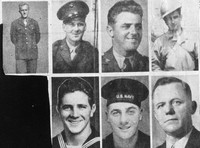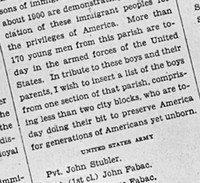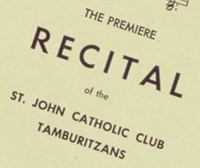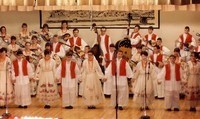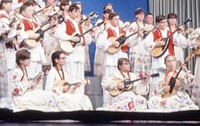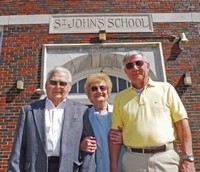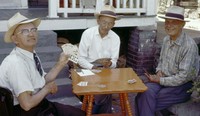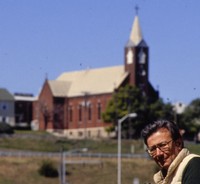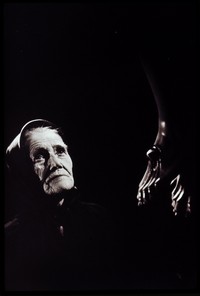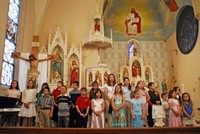St. John's Croatian Catholic school in Kansas City
Donald Wolf, Kansas City,
USA, 2007
(my
deep gratitude to Mr. Don Wolf for this page, D.Z.)
St. John's Croatian Catholic school is closing down after over one hundred years of operation. The present school was built in 1925.
In 1906 my grandparents left Croatia to come to America. My father's mother (Marija Cimpric Stimac) came from the beautiful village of Turke, Gorski Kotar, and my mother's mother (Lena Muhvic) came from the small village of Kamenski Hrib, just up the hill from Plesce where she was baptized. Both of my grandfathers, Rudolf Volf and Mato Cop came from Gerovo.
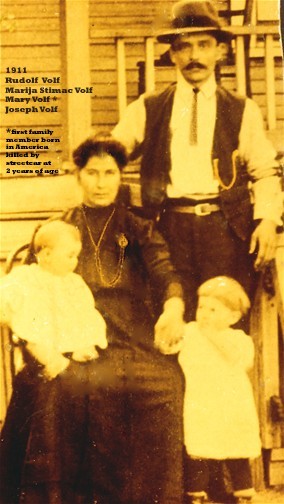
I have visited Gorski Kotar sixteen times and find it very beautiful and the village people are among my best friends.
My grandparents came to Kansas City, Kansas because here were many large companies who needed labor to kill and process cattle, swine and sheep.
Most of the Croatian people that came to Kansas City only had four years of education. But it was important to them that their children were educated and so a school was build about 1904 which was next to the the church which was built beginning in 1900. Both were dedicated to St. John the Baptist.
In the 1920's over 700 Croatian-American children attended this school and so in 1925 a larger school was built.
In our Croatian neighborhood which is called Strawberry Hill, we had everything that we needed within walking distance. We had many Croatian taverns and grocery stores operated by Croatians and Slovenians in the neighborhood. I could walk to five theaters, church, school, shoemaker, grocery store, hardware store, and about thirty of my relatives.
My grandmother Lena came along with her three sisters Anna, Marija and Veronica. They left four sisters in Kamenski Hrib which went to Italian concentration camps for eighteen months during WWII.
My father, Jospip Volf (Wolf) was born in 1911. He had one older sister, Marija, who was killed by a tram when she was three. My father had two other sisters, Anna and Danica and three brothers, Ivan, Rudolf and Anton.
My mother, Josipa (Josephine) was born in 1911 and was the oldest child of Lena and Mato Cop. She had a brother, Matt who served in the military against the Nazi's in Europe and three sisters, Mary, Helen and Agnes.
According to
recollections of old people that attended the school in 1920s, there
were 80 students in their classes. Therefore 9 classes multiplied by 80
would be
560 children in the school.
I was born in 1936 and my brother Joseph in 1940. In school we had Math, Grammar, History (Kansas History, American History and World History), Bible History, Catechism, Singing (I had to sing Oj Ti Vilo, Vilo Velebita before I could graduate) I know that I won't spell this properly but in Kindergarden we sang Jos Hrvataska Ni Propala. My favorite Croatian song is Marijana followed by Kukavica and Oj Maricka Pegla. We had a lot of math, especially working with percentages. The church choir still sings Croatian songs at Christmas and Easter
We were very poor but did
not know it until I went into the Navy and traveled to California. I
was a photographer on an Aircraft carrier and have now been
a photographer for 51 years. I showed many of my Croatian photographs
at exhibits in Kansas City.
I have five children, two step-children and 17 grandchildren in total.
For one hundred years, St. John's school and church has been the center and focus of activity for Croatian Americans in Kansas City. We are now concerned about our future as we have a shortage of priests and many of our people have moved some distance from St. John's.

One of our greatest assets is Mr. Don Lipovac whose father came from Plesce. Mr. Lipovac is known around the world as one of the best accordion musicians. He has kept the Croatian and Slovenian music alive in Kansas City and much of the United States. He was in competition in Belgium in 1967 and placed third in the world and first from the United States.

Don
and Mary Wolf with the sisters of St. Theresa's
St.
Theresa's Orphanage - Dom Sv.
Terezije
Sister Kristina Piskovic
Vrhovec 29, 10000 Zagreb, Croatia
My mother walking up the alley from the grocery store in 1955
My mother in the same place in 1985 Josephine Agnes Cop Wolf
Rev. Martin V. Krmpotich, Born:
in Croatia,
Date of birth: 1868, Occupation: Priest
We were fortunate to have as priest, Monsignor Krumpetic, Monsignor
Stimac,
Father Jadric, Father Loncaric, Monsignor Horvat and now Father Frank
Horvat. Unless something happens, he may be our last
priest of Croatian ancestry. It has been about twenty
years since we have had nuns in the school.
Laying foundation of St. John's church in 1900
Laying of the cornerstone of
St. John's
church.
Notice the horses 1900.
First Croatian school where my parents attended
First Croatian class 1904
St. John's church prior to the
turnpike in
1940s. All the homes
between the church and the camera were destroyed for the new road.
My grandparents in 1913
These photos were taken between 1917 and 1918. It was when the Swine Flu epedemic came to Kansas City and many of the Croatian mothers and fathers died.
The Kansas City
Croatian-Americans
purchased a large house and converted it
into an orphanage for the children who were left without parents.
I was first born grandchild in
America with
Grandma Marija Volf Stimac,
photo from 1936
New Croatian school built in 1925 where I attended
Croatian nuns. The Sisters
originally came
from Graz, Austria and were
members of the Third Order of St. Francis. Most of the nuns who taught
me
were fluent in Croatian and their English definitely had a Croatian
flavor.
Photo from early 1960s.
My graduating a class in 1950
from St.
John's.
Father Charles (Dragutin) Stimac is here and I am seatedt o his left.
In square Armour Paking House
Oval is
Strawberry
Hill, home of Croatian people. Photo of Strawberry Hill and Meat
Packing House was made in 1960s.
Newspaper article about homes
coming down on
Strawberry Hill, printed on June 3, 1957
Spehar's Tavern and neighborhood condemned for turnpike, 1956
Our Croatian/Slovenia Tavern
prior to
turnpike, Newspaper from June 3, 1957;
abandoned tavern waiting for bulldozers to be destroyed
Destruction of Croatian homes, June 1957
Destruction of Croatian homes, June 1957
Strawberry Hill St. John's
church with new
turnpike in foregound
where Croatian homes were;
These are the eight Muhvic
sisters of which
my Grandmother Lena is one.
The first picture is of the Muhvic sisters that were left behind in
Croatia
and went to the Italian Refugee camps where they were starving.
When they returned to Kamenski Hrib and Okrivje, their houses were
burned.
The other four sisters are the
ones who
came to America.
You can see the stark contrast in the clothes that they wore.
I was fortunate to have visited with, loved and been loved by all eight.
Ljubica, the youngest, died in France a few years ago.
I was fortunate to hear her story of the terrible times in the camps.
Photos from 1950s.
When WWII broke out, St.
John's gave to
defend Europe.
Newspaper articles from June 2, 1944
More than any other area in
the United
States, it is in the Congressional record,
that in our little St. John's neighborhood, 170 men went into the
military service
in the first year of the war.
By the time the war was over,
over 425
Croatian American men
were in the military from our neighborhood.
No one gave so much as we did.
25 men died
in the war from our church.
Three uncles, Matt Cop, Ivan (John) Wolf and Rudolf Wolf were in the
army.
I was in Nick Rodina's
tamburitza
orchastra, playing the Bugaria in 1945
but I was a poor musician. So in 1967, Mr. Joseph Kolic, Mr. Joseph
Peresic and myself
organized the St. John Tamburitzans under the direction of Mr. Don
Lipovac.
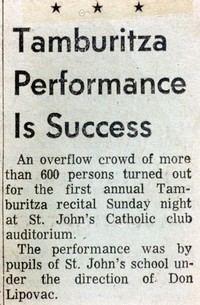
I am sending you photos of the group on the stage at St. John's and at
a local
TV station. We did a program called, "Croatian Christmas on Strawberry
Hill".
Tamburitza recital in 1967.
Croatian Christmas on Strawberry Hill, April 29, 2007
Croatian Christmas on Strawberry Hill, April 29, 2007
The three people are Matt
Stubler (not the
original Croatian spelling)
My teta, Agnes Cop Pavicic, and myself, Don Wolf ili
Volf Matt and I graduated from St. John's in 1950 and Teta
Agnes in 1940. She is my mother's sister.
Three retired Croatian men
playing cards,
1959:
Luka Cavlovic, Blaz Kovac and my grandfather, Rudolf Volf,
Photo of myself in front of St. John's, 2000
One
of my most famous photographs taken at St. John's church, 1968.
This is Anna Zagar. Her husband and my grandfather were a team on a
two-man saw
in the suma [forest] of Louisiana, America. Grandpa enjoyed working in
the suma
but after having so many children she made him stay in Kansas City
where she and the children lived.
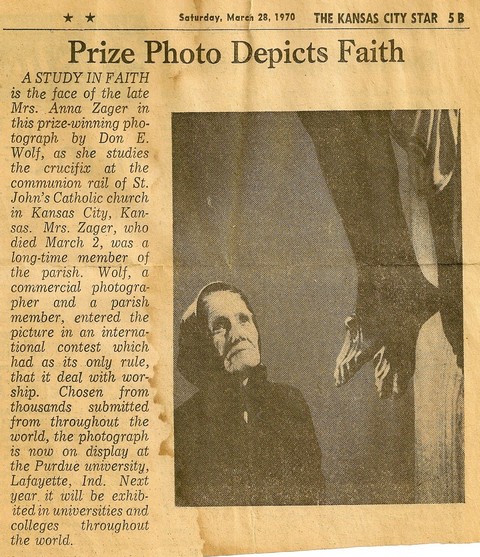
Let me explain. Grandpa tried
working
indoors but after working in the suma of Croatia it was very difficult
for him. After coming to America he worked as a butcher indoors but
then got a job in the suma of Louisiana. He would go there by train,
cut wood and
then come back to Kansas City, get grandmother pregnant and then go
back to the suma. Grandmother then made him get a job in the factory
killing cattle in Kansas City.
These students represent the
last class
and sang at the mass yesterday, April 29th, 2007.
Back row:
Danielle Braun, Carissa Mikesic, Hannah Uziel, Abby Gergick, Tony
Subasic, Angelica Kallman, Ellyn Calvert, Meg Calvert, Fabian Butkovich
Front Row:
Andy Mikesic, Teo Subasic, Ryan Hayes, Vanessa Kallman, Emily Christ,
Michayla Mikesic, Sarah Mikesic, Graciela Lucic, Abby Andrews, Rachel
Uziel,
Anna Mikesic.
Photo by Roxanne Netemeyer, school prinicpal.
Additional information about St. John's church with photos
The following text is from the above source:
|
The Midwest Croatians website at: http://www.midwest-croatians.org/archives/stjohnkc.html has a nice writeup on the parish. St. John the Baptist Croatian Catholic Church The history of Saint John the Baptist Catholic Church is the history of the Croatian people, their religious faith, and the struggle to keep that faith alive while adapting to the culture and customs of their adopted country The first of these settlers tasted the bitter experiences of strangers in a strange land. Unfamiliar with the language and the customs, they had no friends, no countrymen. These good people could not answer even the ordinary questions requiring simple yes or no answers. The thoughts of many in those early days turned to their far-away fatherland, and the recollection was often accompanied by deep sighs and tears. "Pogledaj na mene i smiluj mi se, Gospode, jer sam stranac i siromasan." (ps. 24) As soon as the earliest immigrants, the pioneers, had settled and learned to speak and write English, other immigrants followed. Newcomers were always welcomed with a feast prepared by relatives, friends and neighbors. No sooner had a new arrival rested from his journey than the "old timers" would begin the task of finding him employment in a plant or a factory. He would be hired and begin saving his wages to send home to his parents or wife. His wages were earned by the sweat of his brow. Sweet were the crumbs acquired in this manner. As early as 1888, a number of Croatians settled in this mid-central region of the United States, in the city of Kansas City, Kasnas, formerly called Wyandot, which was the name of a tribe of Indians who were moved by the Federal Government to this area from the East. The earliest immigrants were Ivan Jarnevic, Josip Grisnik, Jure Novak, Janko Car, the brothers Imbro and Miho Skorija, Ivan Crnic, Marko Lorkovic, Ivan Goldasic, Ivan Maca, the brothers Jure and Franjo Ribic and the first female immigrant, Ann Sambol, later Kostelac. These and others who came to the New Wold were witnesses to the lives and experiences of the original Croatian immigrants to Kansas City, Kansas. A house could be purchased for a very reasonable amout of about $500.00 The rent on the real estate was about $1.00 or more per month.In their own homes the new arrivals were their masters. The familiar frangrances blooming in the fields of their homeland were replaced by the stnch of the slaughterhouses and the stockyards, by the smoke emitted from the railroad locomotives and the fumes from the smokestacks of industry. As the number of Croatian families increased, the people began to talk about building a parish church of their own. On May 26, 1900, the Croatians met in Union Hall on West 9th Street in Kansas City, Missouri. On June 26, 1900, it was announced that the property comprising 7 lots, each 25 x 150 feet in dimension, had been pruchased for $1,650.00. The time between October 20, 1900 and February 28, 1901 was spent in collecting funds, selecting members for the building committee, securing a contractor for the church building, and corresponding with priests in Croatia in search for a pastor. The cornerstone of the church was solemnly blessed by the Very Reverend Thomas Moore, V.G., on the 15th day of May, 1904. A magnificent parade accompanied this event. On June 28, 1902, Father Martin Davorin Krmpotic arrived in Kansas City, Kansas from Croatia. He began to work in all earnestness to complete the building of the church. As he knew a great deal about stone masonry, he went out and worked with the rest of the workmen. On one occasion a union agent happened along and asked Father Krmpotic for his union card. The priest looked at the gentleman, smiled, and replied: "I do not need any union card; I am building my own church." He added: "I don't think that St. Paul had a union card while he carried on his trade of tentmaking." The flood of 1903 dealt the "Patch" area a mortal blow. The Missouri and Kansas Rivers flooded the entire part of the city which lay along the Missouri near the mouth of the Kansas River. After the flood, a few of the people returned to the "Patch", but most relocated to the immediate vicinity of the new church building which was under construction, the better to rear and educate their children in the spirit and faith of their ancestors. The area became to be known as "Mala Hrvatska" (Little Croatia). Through Father Krmpotic's influence, Oton Ivekovic, belonging to the school of painting at the University of Zagreb, Croatia, was called to fresco the church in 1908. He felt honored as this was the first time he was invited to exhibit his skill in America. With his brush and easel he set to work, being mindful of the words of the poet Keats, "A thing of beauty is a joy forever." His great genius was poured into his work of art. In 1907, a new frame building housing the first Croatian Catholic School in the United States was blessed. The Sister of the Precious Blood were the first teachers but they were recalled. On October 11, 1909, four Sisters of St. Francis arrived from Maribor. Throughout the years sisters of this order have conducted the school with zeal and devotion. In 1918, there was an influenza epidemic. It took a tremendous toll among the Croatian people. Many children lost their parents. In some cases many widowed mothers were forced to seek employment to gain a livelihood for their little ones. Father Krmpotic called a meeting of the parishioners, acquainted them with the dire conditions that existed, and proposed the building of an orphanage and day nursery. The orphanage would be for those children left without parents and the day nursery for the care of the children whose mothers had to work. Father Krmpotic sought and obtained the consent of the Franciscan Sister to supervise the orphanage. Today this building is the home of the Strawberry Hill Ethnic Museum. In the 1950's, the Department of Transportation swept through this ethnic community and razed almost half the homes in the area. Despite this enormous setback, this parish still thrives. It has still maintained it's school and the parish community still thrives. Many old-time parishioners still drive twenty to thirty miles each Sunday to attend Mass. The Church's current parish priest, Father Frank Horvat, has tried to continue the traditions of the past for his parishoners while bringing up-to-date with the 21st Century. It is the hope of the parishioners that the Croatian tradition will still be kept alive as a reminder to those who helped begin this parish over 100 years ago. This country has given haven to millions of immigrants from southern and eastern Europe during the past century. They came to the teeming cities and ethnic neighborhoods of every metropolitan area in the United States. Many were absorbed completely and lost their identity. Our pioneer fathers clung tenaciously to their Catholic and Croatian identity while absorbing the best of American Citizenship. They have given their children every advantage that this great country can provide, but they have not permitted their ethnic identity and the richness of their heritage to be forgotten. Archbishop Jean Jadot, then Apostolic Delegate to the United States, stated: "There is a realization that there are important values in one's own ethnic and cultural traditions and in the tradition of others, which should not be submerged and snuffed out, but rather cherished and preserved." As Saint John the Baptist Croatian Catholic Church celebrated its 100th anniversary, that dream of continuing the Croatian tradition of our ancestors burns so brightly. May the members of all the Croatian communities realize that their heritage is not a birthright, but a responsibility to continue what has been given to them. Source: Text taken from the Diamond Jubilee 75th Anniversary Book of Saint John the Baptist Church. |
Links related to Don Wolf:
- Donald Wolf
- Don Wolf's photo exhibition "Images of Croatia" - Kansas City, Kansas USA
- Don Wolf photoraphs Croatia
- Croatian connection endures through years
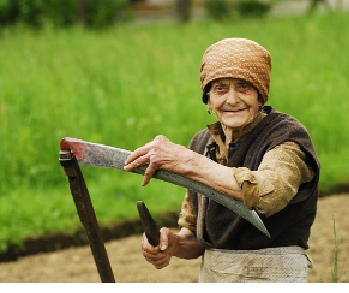
Wolf delighted in the opportunity to document the peasants of his ancestral land and their way of life. Here, 96-year-old Marija Kuzeli sharpens the blade of her scythe as she prepares to trim grass.
In May of 1997, I had the
opportunity and privilege of leaving the orphanage for awhile and
visiting the Piskovic vineyard with Sister Katarina. I was a beautiful
day and the family was so happy to have guests come to their house. We
had a great meal in the home and then went to sit at a picnic table
under a tree and sang and
sang and drank. It was a fantastic time and I think that I was the only
one
who spoke English but it didn't make any difference. Sister Katarina
told me last June that this was her Father's favorite photograph. That
really is rewarding.
Grandpa Wolf
Rest in Peace Ljudevit Piskovic, Father of Sisters Katarina and
Kristina.He
has to be looking down with great pride knowing what his daughters have
accomplished.
From Don Wolf's e-mail sent in February 2009.
St. Theresa's Orphanage in Zagreb
Don Wolf's photo exhibition "Images of Croatia" - Kansas City, Kansas USA
Don Wolf Croatian photographer and benefactor in Kansas City USA
Links related to the region of Gorski Kotar, Croatia:
Croatia - its History, Culture and Science
